Growth Mindset at Newton St. Cyres
Growth Mindset underpins classroom practice across the school and has been fundamental in helping children overcome barriers to learning. This page will help to explain what growth mindset is and the powerful impact it can have in the classroom and wider school environment.
What is Growth Mindset?

Growth Mindset is a concept developed by American psychologist Professor Carol Dweck. Dweck says "A growth mindset is when students understand that their abilities can be developed,”
“In a growth mindset, people believe that their most basic abilities can be developed through dedication and hard work—brains and talent are just the starting point. This view creates a love of learning and a resilience that is essential for great accomplishment.”
By contrast, in a fixed mindset "people believe their basic qualities, like their intelligence or talent, are simply fixed traits. They spend their time documenting their intelligence or talent instead of developing them. They also believe that talent alone creates success—without effort.”
How Does Growth Mindset Work?

Growth Mindset and The Learning Pit
Another strong advocate of growth mindset is James Nottingham. He is regarded by many as one of the most engaging and thought-provoking presenters in the world of education. Nottingham created the 'Learning Challenge' which encourages learners to investigate contradictions and uncertainties so that they might more deeply understand what it is they are thinking about. It is is a frame of reference for students to talk and think more accurately and extensively about their own learning.
At the heart of the Learning Challenge is ‘the learning pit’ which shows the learning journey of a student, addressing a new concept, revealing contradictions or conflicts with the knowledge, confusion, combining new and creative ideas and ultimately reaching the clarity of conceptual understanding.
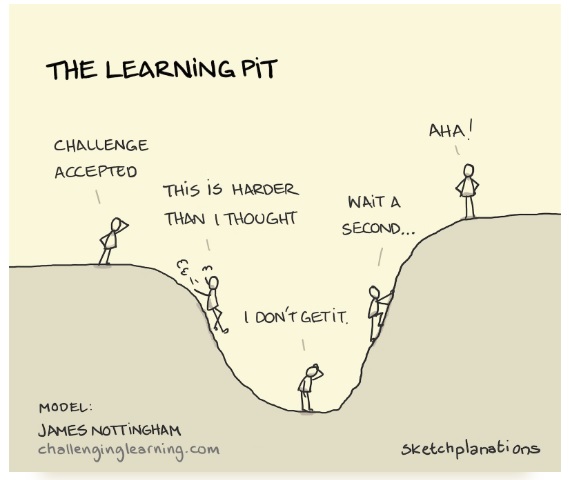
Nottingham says "It’s vitally important for children to see mistakes as opportunities.
The learning pit encourages children to be taken out of their comfort zone so that they might discover insights that are more meaningful and long lasting. The confusion element is dealt with by practical investigations until they reach a ‘Eureka’ moment. Those at the Eureka moment earlier can be sent back into the pit to help the other children out.
What Are the Benefits of The Learning Pit and Growth Mindset?
- The Learning Pit is one of the most effective ways to encourage students to come out of their comfort zone.
- Knowing why, when and how to apply challenge with learning allows students to move from basic academic level to full-blown learning experience.
- Collaborative thinking in a safe atmosphere of classroom practice help students to improve their emotional and social skills.
- Learning pits help to develop skills of connection, inference, reasoning and positive behaviour for learning.
- A challenging classroom culture helps students to learn complex concepts and builds a holistic understanding of the surrounding world.
- A safe classroom environment where mistakes are celebrated encourages students to work harder to reach their 'Eureka' moment.
- Sending children back into the learning pit to support another child increases their chance of understanding by 90%.
Growth Mindset at Newton St. Cyres

At Newton St. Cyres, in the core subjects we use chilli challenges to differentiate the difficulty of work in class. They are labelled as 'explore', 'discover' and 'challenge.'
Our new rolling programme ensures that all areas are covered even though we are in mix aged classes. The teacher delivers a teaching input to the whole class and then the pupils choose which task to complete based on their understanding:
- Explore- "I found that input tricky, I would like some additional support today and an easier task to complete"
- Discover- " The input was at the right level. I understood that and this level will stretch my learning today"
- Challenge- "I understand this concept well and feel I can push my learning on. I am keen to move out of my comfort zone and tackle harder concepts.
Groups are fluid and can be amended quickly and efficiently within lessons. Our new marking and feedback systems mean that staff circulate round the classrooms intervening quickly. Children can be moved on to trickier challenges, or be offered more scaffolding to understand a concept better.
Growth Mindset and Higher Order Questioning
To develop all lessons, we use Bloom's Taxonomy Higher Order Questioning to ascertain a child's understanding and to extend their learning further. Bloom's Taxonomy has 6 levels which increase in complexity.
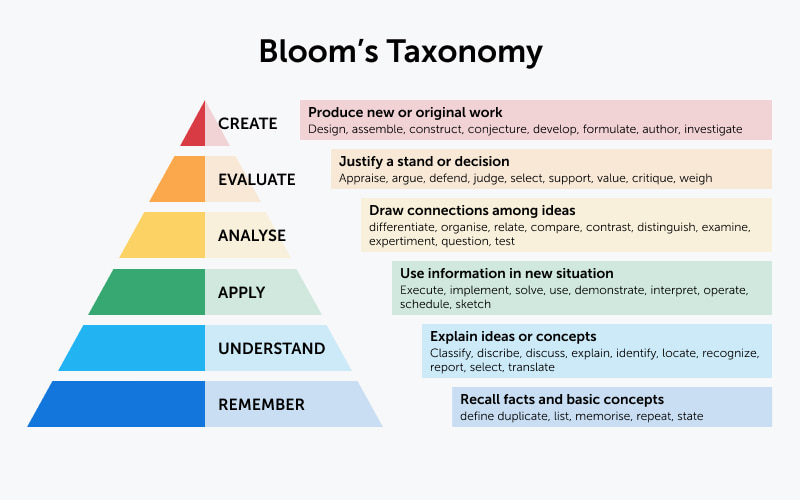
1st Level: Remember
2nd Level: Understand
3rd Level: Apply
4th Level: Analyse
5th Level: Evaluate
6th Level: Create
In school, we use question stems from the Bloom's Taxonomy pyramid and match them to the 3 levels of challenge. Children use these to guide their thinking at the end of a lesson.
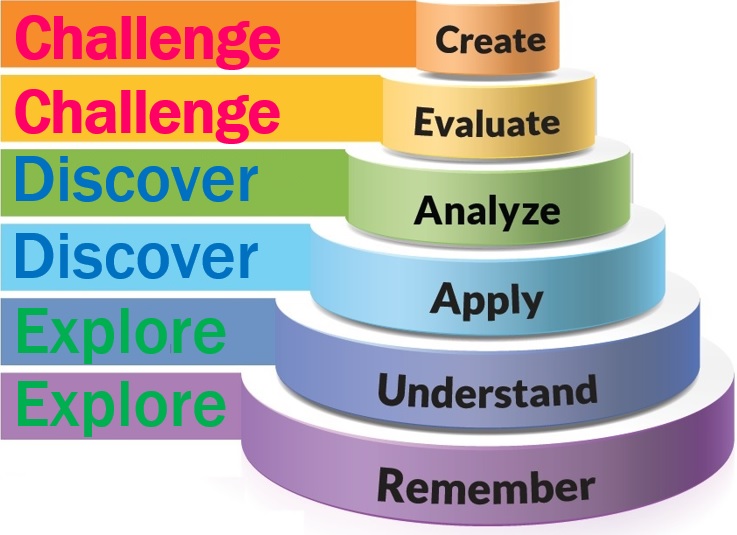
Using the same premise as the 'chilli challenges', children choose a question based on how well they feel they have attained in that lesson. This is answered in their books and assessed by the class teaching team. This adds a further layer to assessment and offers a child the opportunity to display 'mastery' of a subject area; showing that they have learned or understood it completely and have no difficulty using it.
Here are some worked examples of our higher order questioning:
Marking, Assessment and Growth Mindset
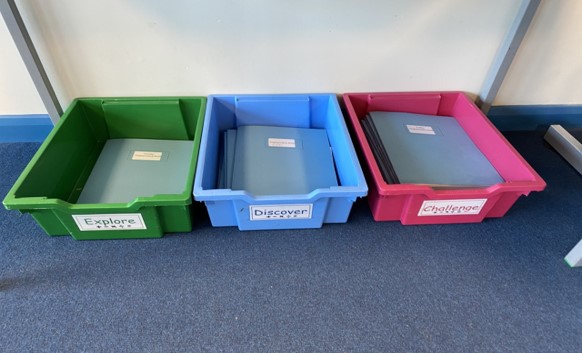
At the end of each lesson, children have one further task, which is evaluating how they feel they attained. Once their work and the challenge question is completed, they put their book in one of 3 coloured trays (see left).
Explore: " I struggled today and would like some further support tomorrow"
Discover: "This lesson was right for me. It extended my learning and I will continue with this tomorrow"
Challenge: "I did well today and would like to extend my learning much further tomorrow. I'm happy to leave my comfort zone and extend my thinking."
The class teacher then views the books if marked during the lesson, or spends time reviewing the books after the lesson. Our new marking policy links closely to the colours of 'explore' 'discover' and 'challenge' and they will strike through the learning objective or learning question with a green, blue or pink highlighter.
For the teacher/teaching assistant, this means:
Green (Explore): A great effort. I can see you found this tricky today. Your work is not as accurate as it could be and we will spend some additional time tomorrow supporting you with this.
Blue (Discover): Well done. You have understood the objectives today and worked hard to complete the work. There are a few small areas to edit, but your overall understanding is sound.
Pink (Challenge): Well done. You have excelled today and really extended your learning. Your high level of accuracy with this work means you are ready to push yourself further tomorrow.
Once this is complete, the teacher/teaching assistant reassigns the books into the boxes (if needed). Those children in the explore tray will receive a pre-teach session with the class teacher or teaching assistant the following day. This time is allocated before English and maths each day. The session revisits the previous days learning and also touches upon the new learning for the current days teaching.

Once blocks of work have been completed, the teacher can use assessment sheets to track progress. Usually, an elicitation task will be used at the start of a topic or block or work to ascertain how much a child already knows. This will be marked and assessed using the 3 assessment colours. The example on the left shows a large volume of green (explore) and blue (discover) meaning that there are gaps in learning and blocks of teaching will be completed to address this.
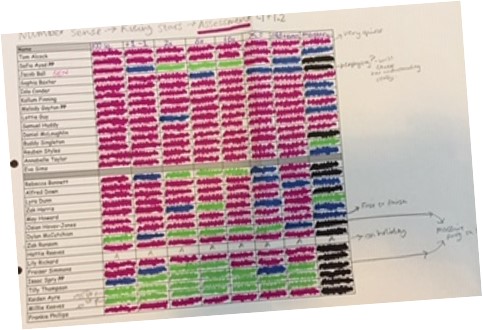
Once a block of teaching is finished, an assessment task will be used. This may be at the end of the block, or at the end of a half term. Successful teaching and assessment combined with additional support through pre-teaching means that the assessment sheet will have more pink (challenge) shading, demonstrating progress from the elicitation and a better understanding on the concepts covered.
Those children who have remained at green (explore) or blue (discover) will continue to be a focus and have additional interventions.
 Exe Valley
Exe Valley